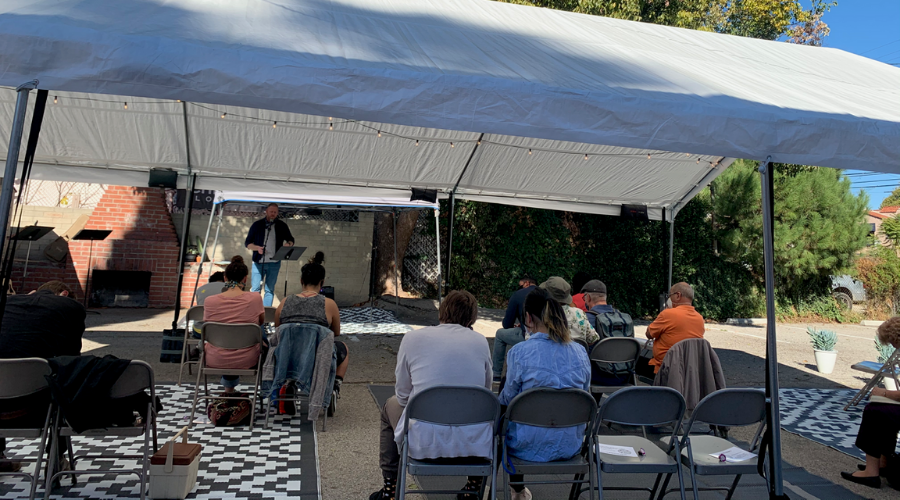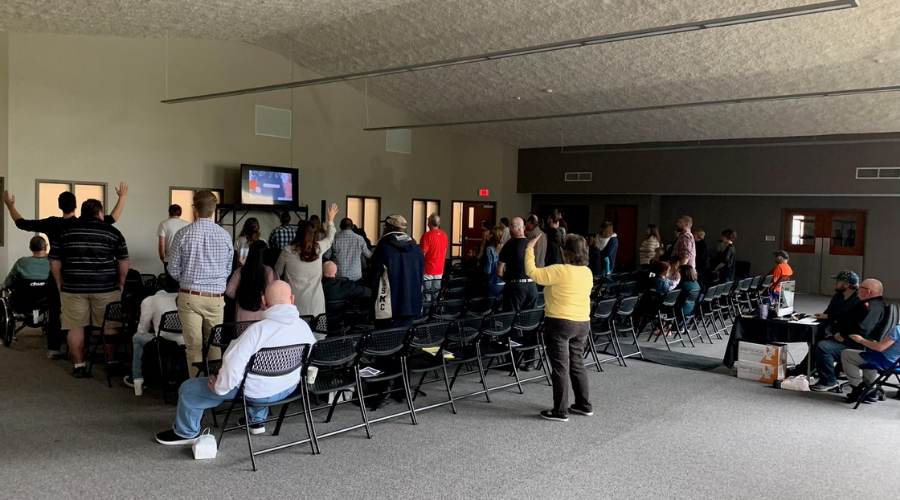
South of Houston, Manne Favor is starting his third church during a cultural moment that forces a new perspective on churches planting in 2021 ― and existing congregations.
“It’s a reflective time,” he said. “It’s making us confront our assumptions and things that we perhaps took for granted. Those things are no longer holding true, so we have to find new ground zeros, if you will, of where to start from and how we do it.
Favor, originally from Nigeria, became a missionary to the Netherlands and planted a church in 2000. While in the Netherlands, planting that church over a four-year period, Favor said people called him the ‘tech pastor.’
“It wasn’t a term of endearment,” he says, laughing. “They were saying I was worldly because I was using technology to get the gospel out.”
Now, in the pre-launch stages of The Connect Church in Pearland, a diverse suburban community, Favor said every church must embrace what it wasn’t utilizing before, like social media. The bedlam of 2021 is “requiring we change our paradigm of how we connect, of how we meet. It’s challenging in a good way.”
Related: Social media & the church (Unfiltered church planting podcast)
Even before the turmoil and confusion of the last 12 months, Tim Ponzani, Converge Northeast district executive minister, was considering how Christ’s mission advances through churches starting churches.
“The reality is, you have to do more multi-dimensional planning if you’re contemplating launching in 2021 or even 2022,” he said. “You need to have your general direction, but your plans need to be nimble.”
Planting churches in a pandemic sparks creativity for finding spaces
He said Converge Northeast church plants typically begin with 35 to 50 people. Now, churches are starting with even smaller clusters to navigate restrictions on in-person gatherings and inhospitable winter weather.
Schools, movie theaters and community centers usually are great for a new church to rent. Those places are almost impossible to rent due to the pandemic, a challenge that church planters are overcoming around the country.
At The Table, outside Boston, Josh Wilson is in the pre-launch phase, moving forward with small groups on an uncertain time frame. Their more public, grand opening style Sunday service was supposed to happen in 2020. Now, sometime in 2022 looks to be the more realistic option.
“Nobody went in with plans to plant during a pandemic,” he said. “If hypothetically, we could rent a school and gather people, it would hurt us in the community from a place of witness. People would see it as ‘you don’t love your neighbors; you don’t care about the people in your community.’”
In southern California, Christ Church Los Angeles meets under a large white tent set up in another church’s parking lot. While southern California weather isn’t a factor, prices to rent space, even for a few hours, matter.
“If you’d asked me a year ago if we’d be meeting in a tent, I would have said that was crazy,” said Christ Church pastor Ken Lippold. “But now, I think it’s the best thing we could do to have a semi-permanent structure.”
Fifty-five people have visited Christ Church, which joins The Connect Church as Converge Southwest congregations. Almost every single person who came did so because of a personal invitation. “They come because of an invitation; that’s an old, old pathway. How do we leverage that?” he asked.
Across the country, in a multicultural Philadelphia neighborhood, Rick Martinez is starting Echo Church. For now, the church is worshiping online, a choice they made because of their context and COVID realities in their community. Having received a $12,500 grant for new churches among people of color, Echo is equipped to start now and begin ministering to the community through online resources.
“Everybody’s on social media,” he said. “So, you don’t know who you might be able to bless and who might be able to bless you from a distance. The grant definitely set us up for meeting in person (when they can) and meeting online.”

Frank Gil, the campus pastor for the soon-to-open Mayfair Road campus of Epikos Church in Wisconsin, expects a launch service March 21.
“There have been some days when I just have to fall on my knees and ask the Lord for creativity because I know I don’t have it,” he said.
Nate Hettinga, who has planted a church that planted many other churches and now serves as district executive minister for Converge Northwest, has total confidence in church planters. He knows they are innovators and creative problem solvers.
Like in New England, many churches in the Northwest have trouble finding a building at the local school or community center. One church had nowhere to go for a building. So, they worshiped in an outbuilding on the church planter’s property.
When the county government confiscated church signs because zoning for the property doesn’t allow meetings, the church spray painted ‘Underground’ on a remaining sign. Now that sign is all over social media, a vital part of the church’s communication strategy.
This cultural moment challenges methods for new, existing churches
A major initiative has begun to plant 312 Converge churches by 2026. Multiple Church Planting Assessment Centers around the country are happening this year. Several districts’ representatives and pastors said there is more motivation and devotion from church planters in the last 12 months than they’ve seen in years.
“The gospel always flourishes under pressure, so we are on mission with greater clarity from my vantage point,” said Hettinga. “The pressure of the changes have crystallized either the problems within a church or the purpose for which it exists.”
In his district, Oregon, Washington and Idaho churches navigate different restrictions with adjusted forms of the church. Some are meeting in homes after the pastor commissioned their people to be the church, scattered as the people are to go and be the hands and feet of Christ. Idaho is wide open on in-person gatherings, so churches there worship in ways that Seattle churches aren’t.
For Glenn Herschberger, Converge Great Lakes’ executive church planting director, “There’s a great reset going on in the American church. I think we’re asking more intentional questions that we didn’t ask even a year ago.”
Joel Nelson, Converge North Central’s director of Starting, is also seeing a more active church scattered to serve. “How can we focus on being the body of Christ and ministering individuals instead of being Sunday-centric?” he asked.
Jarrod McClintick, who planted Rise Church in 2009 in Visalia, California, said his church has been considering spiritual and programmatic changes. He is now on Converge PacWest’s assessment center team for new churches.
There’s a great reset going on in the American church. I think we’re asking more intentional questions that we didn’t ask even a year ago.
When COVID first stopped their in-person gatherings, he said the church shifted the high percentage of their resources for weekend services to meet community needs. They reallocated a larger portion of their volunteers and budgeted expenses to missional pursuits.
“We had such a main focus on evangelism for the last five years that we had hundreds of people come to Christ,” he said with total gratitude. But he knows some reflection was needed. “We’ve had to look at all the things the Bible calls the church to do and find the healthy balance.”

Outside Dallas, Heart+Soul Church, another member of Converge Southwest, has had an eventful, chaotic start since the first service six weeks ago.
They had 200 people on January 24 for the first service, pastor Justin Schultz said. They had two more services in the rented middle school before a massive snow and ice storm hit Texas in February. That forced the church to go online for two weeks when the middle school became a 24/7 warming shelter. When the church showed up at the school, they weren’t there to worship but take care of their neighbors.
Now, they’re back in the school and doing services online. They have an online pastor who connects with church worshipers watching the live stream who need spiritual interaction. Meanwhile, Schultz and other members of the team are serving those gathered in person.
The governor of Texas has said masks are not required for public spaces, businesses and churches. But the school district that rents space to the church still requires masks in the building.
“I think of (church planting) like chess or checkers,” he said. “It’s one piece at a time, one move at a time.
“Church planters come from the same DNA: we want to go 100 miles per hour. It sounds good in theory. It’s not good in reality.”
As a result, Schultz is pursuing the vision of a multicultural, multiethnic community. After six weeks of dramatic change, he’s patiently watching for the next massive adjustment he needs to make.
“This is starting a church. It’s already a miracle. We count just having church as a victory. Everything on top of that is just icing on the cake.”
Cultural disruption hasn’t weakened strong faith of church plants
Before 2020’s chaos, most Anglo church plants could be financially self-sustaining after three years. According to Converge Heartland’s district executive minister Jim Capaldo, an African American church could be financially self-sustaining after seven years.
Not now, Capaldo said.
“In 2021, I think it looks bold. It’s boldness. It’s bold faith on behalf of the supporters whose incomes are uncertain. It’s bold faith on the planters who are going up against a variety of restrictions regarding COVID.
“For a church to say we’re going to send a church planter is a bold move,” he said. “But you go forward in bold obedience, saying this is what we ought to do.”
To help church planters, Converge churches gave generously for the Launch Offering a few weeks ago. Together, the people raised $529,454 for church plants to receive when they launch.
Related: Converge to church planters: “You are not alone.”
Currently, all church plants receive a $5,000 grant, while church plants targeted to or among any people of color can receive an extra $7,500. The Converge aims to increase those figures through the Launch Offering.
For a church to say we’re going to send a church planter is a bold move. But you go forward in bold obedience, saying this is what we ought to do.
McClintick, of Visalia, California, said a wise step for many existing churches is sharing their building with a church plant or merging with a church plant.
“It takes a kingdom-minded, one body approach. It can be really fruitful,” he added.
Related: Multisite, merger, fostering, adopting ― what’s in your church’s future?
Long-term changes to existing churches and church plants are likely
Brian Weber, the district executive minister for Converge Mid-Atlantic, sees reflection happening across the country’s churches, whether new or existing.
In 2020, he said, most churches were changing their strategy to cope with pandemic realities. Now, in 2021, he said churches and church plants are “transitioning away from ‘how do we adjust?’ to ‘what is the future of church ministry?’”
Related: Cowards & killers: pastors divided into two camps over reopening strategies
Future churches, he said, may have a different methodology for disciple-making, especially utilizing a holistic digital model that embraces Zoom, Facebook and other digital tools.
According to Weber, another transition is a transition away from big event outreaches to grassroots neighborhood outreaches.
“These are real paradigm shifts, born out of necessity because the pandemic restrictions are here, but people are dreaming about these as necessary changes to disciple-making in the American context that are here to stay.”
Danny Parmalee, Converge MidAmerica’s vice president of Church Planting, said God gave the pastor of Hope Church in Knoxville, Tennessee, a church designed for these paradigm shifts before they happened.
“It’s not radical,” he said of Pastor Charley Dever’s approach to ministry. “People are saying it counts to do church in different ways. Church is not just Sunday morning.”
Ken Lippold sees Los Angeles with fresh eyes after growing up in Chicago and living in England for seven years. “Everyone, whether you’re a church planter or not, is assimilating into a new culture. It’s a new time in history, so we need to be asking the right questions.”
According to John Ames, a church planter and member of the assessment team for Converge Northeast church plants, this is a time for introspection before the work continues.
“I think, if you look across the Christian landscape, whether it’s an existing church or those who are pushing out and wanting to plant churches, this next season is a season to rebuild, like Nehemiah repairing the walls of Jerusalem,” he said. “It’s coming to the ruins of the wall and saying, ‘let me weep over what’s just happened.’ Then, let’s get to work and trust God to do it.”
Converge is committed to starting missionally minded churches until every people group and community has heard the gospel. Learn how you can make an eternal impact through church planting.